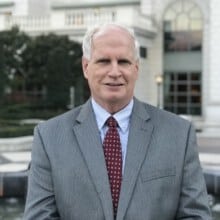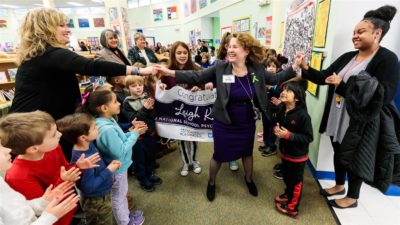

Last week, Gov. Roy Cooper extended the closure of all public schools in North Carolina through May 15 via executive order. Among other things, Cooper said the extension is necessary to promote public health and safety in the wake of the coronavirus outbreak.
The impact of the decision is far reaching. With $9 billion in state spending and a combined $14 billion when federal, state, and local expenditures are included, K-12 public education is the single largest item in the state budget. The closure means that over 1.5 million students will not be attending public or charter schools. In addition, 173,000 professional staff — including 94,000 teachers and almost 56,000 non-certified staff — will either be working from somewhere else or not working at all.
The decision and the expected aftermath of coronavirus raise new challenges and questions: How will children learn? How will the recession impact the schools? Can the public schools integrate distance learning? Will teachers and other staff be paid when schools are closed?
These are complicated questions, but not without answers. There are short-term and long-term steps policymakers can take to mitigate the impact of coronavirus on the public schools and improve education for all children in North Carolina. Let’s review some short-term steps lawmakers could take to provide relief during this crisis. 1
Provide local districts with more flexibility.
The unprecedented challenges facing schools means that individual districts need to be equipped to respond to changing needs and resource levels. Lawmakers should give schools flexibility regarding how they provide 185 days of instruction within a nine-month calendar. With schools closed for at least eight weeks, it will be impossible for many districts to meet those requirements. Extending the academic year into the summer is one option as is beginning the new academic year earlier.
In addition, districts need flexibility to deal with the impacts of changing the ways education is delivered and a reduction in revenues from an expected recession. Because of school closures, districts should be able to save costs on professional development, substitutes, and transportation. The legislature should incentivize districts that take proactive cost-saving measures like protecting reserves, freezing hiring, re-opening contracts, reducing recurring costs, and controlling benefit costs.
Maximize choice.
Considerable polling data confirms that parents desire more educational options. 2 Not all districts have access to the same resources or online capabilities. To minimize those inequities, lawmakers should consider using a percentage of per pupil spending to provide parents with an Education Savings Account (ESA) that they can use to purchase curriculum, books, tutoring, or other educational resources to assist with home learning.
As the number of home schools has exploded in the last few decades, lawmakers can make changes to home school law that would improve the experience for many families who now find themselves homeschooling in difficult circumstances. Suggested changes include waiving the requirement to have a nine-month schedule, waiving the requirement for disease immunizations, and expanding the definition of a home school to include children of no more than four families or households whose parents determine and deliver the academic instruction. The last change will facilitate tutoring and legalize what is already happening in many neighborhoods.
Serve meals to needy students.
Public schools do not have a legal obligation to provide meals when school isn’t in session. However, considering the unprecedented circumstances we find ourselves in, school districts that have the resources to do so should continue to serve eligible children federally reimbursed school meals through the end of the academic year. Minimal state dollars are involved. However, such examples not only highlight the central role schools play in the life of various communities but also how schools can partner with local community groups or charitable organizations to serve children in need.
Resolve rural broadband and connectivity issues.
North Carolina’s pivot to online learning only highlights that many rural areas in the state still don’t have adequate internet service. Lawmakers should resist the temptation to allow municipalities or private/public partnerships to provide such infrastructure. They haven’t worked, plus companies should not compete with government.
Municipalities were forced to raise taxes and rates for municipal services to cover losses. The Level Playing Field Act, passed in 2011, was meant to correct such abuses. Lawmakers can incentivize rural broadband development by streamlining the permitting process, eliminating regulatory obstacles, encouraging cheaper technology alternatives, and finding better ways to allocate existing federal subsidies.
Pivot to online learning.
Cooper’s executive orders stress that while schools may be closed, learning must continue. With the spread of coronavirus, learning — in practical terms — means online learning. While some districts have online learning capabilities, instruction is spotty and unevenly delivered.
The North Carolina Virtual Public School (NCVPS) has provided online learning for over 540,000 students since 2007. Currently, NCVPS is supporting students from districts that closed due to coronavirus. While NCVPS is the second largest online school in the nation, the current budget and availability of teachers imposes limitations on NCVPS’s ability to respond to the current school closure.
Lawmakers should consider increasing the NCVPS budget to handle the influx of online students and also begin a program to help train school districts and teachers to develop online instruction. In addition, lawmakers may wish to develop an Education Savings Account (ESA) for teachers. The funds could be used by teachers to pay for professional development that aids online class development and virtual teaching methods.
Don’t forget special needs students.
Districts that provide instruction to traditional public school students during the school closure are also obligated to provide services to special needs students. School closures present significant challenges to special needs students, approximately 12% of the student population. To help meet these expanded needs, we suggest lawmakers develop an emergency ESA program for special needs students, all of which could be administered within the existing special needs ESA program. The current program allows parents to use funds from the account for educational resources, therapies and other assistance for their special needs child.
Give districts authority to address pay issues.
During the school closure, public schools are directed to provide instruction. To the extent that teachers and other staff are performing or trying to perform their responsibilities, they should be paid — through the end of the year if necessary. Schools already include the funding in their budgets.
Regarding hourly employees, if local districts can employ services to meet changing needs, they should be paid. If needs change, districts should have the right to lay off or terminate hourly employees. Districts need the flexibility to hire and move teachers and staff to better manage this emergency situation.
Schools may extend into the summer months to cover required material. That will require additional funding. Additional money may be found in the rainy-day fund and unreserved cash. School closures by districts should also be able to generate savings and districts should be incentivized to do so.
Coronavirus has upended public education and presents numerous challenges to students and the thousands of individuals who staff the North Carolina public schools. Taking prudent steps now can help mitigate the educational and economic impacts of coronavirus and allow our public schools to better meet the needs of students and the educators who serve them.




